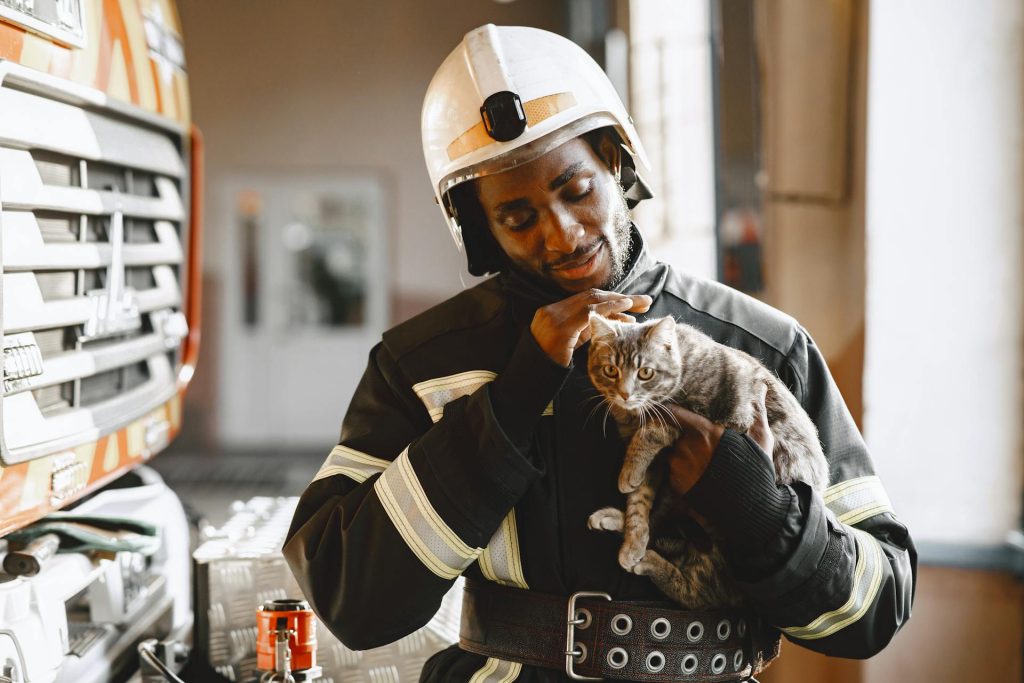
15 Life-Saving Tips for Pet Emergency Preparedness in Apartments
When you live in an apartment, emergencies can escalate fast. Whether it’s a building fire, severe weather, power outage, or medical crisis, every second counts—and your pet depends on you to act quickly, calmly, and confidently.
That’s why pet emergency preparedness in apartments isn’t optional—it’s essential. With a few simple steps, you can protect your dog or cat, reduce your own stress, and be ready for anything from smoke alarms to full evacuations. Here are 15 life-saving tips to help you get prepared without overwhelm.
1. Build a Pet Go-Bag With 72 Hours of Supplies
Just like you need an emergency kit, your pet does too. Keep a small backpack or tote by your door with 3 days’ worth of food, water, collapsible bowls, medications, a leash, copies of medical records, and a recent photo of your pet.
Add a comfort item like a toy or blanket, plus extra poop bags or litter. This bag should be portable, ready-to-grab, and refreshed every few months. A full checklist is included in our guide to setting up a pet first aid kit for small spaces.
2. Attach a Pet Rescue Alert Sticker to Your Entry Door
In case of fire or evacuation when you're not home, a pet rescue sticker tells emergency responders there’s an animal inside. It should list how many pets you have, their species, and your emergency contact info.
Place it near your door’s window or mail slot—anywhere a firefighter or building manager would spot it first. Many animal organizations offer free or low-cost versions.
3. Keep a Carrier or Crate Easily Accessible
In an emergency, you may only have a few seconds to grab your pet. Don’t waste time digging a crate out of a closet or disassembling it. Keep it clean, assembled, and within reach—ideally near your go-bag.
If your dog doesn’t typically use a crate, practice “loading drills” so they associate it with calm exits. Cats should have a ventilated carrier that stays open in daily life so they don’t fear it.
4. Store Extra Medications in a Labeled Pill Organizer
If your pet relies on daily meds or supplements, keep a 3–7 day supply in your emergency kit. Use a labeled weekly pill organizer to separate doses and avoid carrying bulky bottles or forgetting key treatments during stress.
Be sure to rotate these meds every couple months so they don’t expire. If your vet offers written prescriptions, keep paper or digital copies in the bag as well.
5. Make a Fire Escape Plan That Includes Your Pet
In a building fire, smoke spreads fast and hallways can fill with panic. Know at least two exit routes from your unit and building—one for regular use, and one backup path. Practice exiting while holding your pet carrier or leading your leashed dog.
Make sure all roommates or family members know who’s in charge of the pet during an evacuation. If possible, assign one person to grab the pet while another grabs the emergency bag.
6. Keep Flashlights and Batteries in Pet-Friendly Zones
During power outages, you’ll need light to guide both you and your pet to safety. Keep flashlights or headlamps in drawers near your pet’s sleeping areas, crate, or main entry path—not just buried in your own emergency kit.
Avoid candles or lanterns with open flames if your pet is loose in the apartment—they can easily be knocked over. Battery-operated lights with long runtimes are safer and more reliable.
7. Secure ID Tags, Microchips, and Updated Contact Info
If you and your pet get separated during an emergency, clear identification is your best chance of reunion. Make sure your pet wears a collar with an up-to-date ID tag—even indoors—and that their microchip info is current.
Include your cell phone, email, and an alternate contact if possible. Microchip registries like HomeAgain or PetLink let you update your info anytime, and many offer 24/7 recovery assistance.
8. Prepare a List of Pet-Friendly Evacuation Shelters
Not all emergency shelters allow animals. In advance, identify hotels, friends, boarding facilities, or city-run evacuation sites that accept pets. Some communities post official pet shelter maps during storms or wildfire seasons.
Write down a short list and keep it in your go-bag and phone. Knowing where you can go saves time, gas, and last-minute panic if you have to leave quickly.
9. Freeze a Contact Card to Leave in the Fridge
First responders often check the fridge for emergency contacts during home calls. Leave a plastic bag inside with your pet’s photo, vet name, medications, microchip number, and a backup caregiver contact.
You can also leave a note on the bag that says: “Pet inside. In case of emergency, contact [Name/Phone].” It’s a simple backup in case your phone isn’t reachable or you're injured.
10. Practice “Grab-and-Go” Drills With Your Pet
Emergencies are chaotic. Practicing quick exits with your dog or cat teaches them what to expect—and gives you muscle memory for high-stress moments. Grab the go-bag, leash, or carrier, and do a full exit once a month.
Reward your pet with praise or a treat after each drill so they associate it with calm routines. These short rehearsals can make all the difference in a real evacuation.
11. Save Important Records Digitally and in Print
In a disaster, access to your vet records, vaccination proof, prescriptions, or ID photos may be limited. Save digital copies in your phone’s notes app, email, or cloud drive—and keep printed versions in your go-bag.
This is especially important for boarding facilities or emergency shelters that require up-to-date rabies certificates and vet contact info before admitting your pet.
12. Stock Up on Portable Pet Sanitation Supplies
If you're stuck indoors or in a shelter, sanitation becomes essential. Pack puppy pads, waste bags, disposable gloves, pet-safe wipes, and small trash liners in your emergency kit.
These items help prevent indoor accidents, contain odors, and keep your shared space hygienic. For apartment dwellers, this is especially helpful during fire alarms or long power outages when elevators are down.
13. Label Your Pet’s Carrier with Emergency Details
In the event you’re separated from your pet, or someone else has to evacuate them, your carrier should include all essential info. Attach a luggage tag or duct tape label with your name, phone number, vet contact, and any medical conditions or allergies.
This is especially important if your pet is traveling in a shared rescue van, boarding facility, or shelter. It helps responders act quickly and avoid mistakes.
14. Assign a Backup Pet Guardian in Advance
If something happens to you—accident, hospitalization, or evacuation delay—who will care for your pet? Choose a trusted friend, neighbor, or family member as your pet’s emergency contact.
Share feeding routines, med instructions, and key locations like your apartment entry code. You can also include their info on the pet’s ID tag or microchip record as a secondary contact.
15. Review and Update Your Emergency Plan Every Season
Your apartment, routines, and gear change throughout the year—so should your emergency plan. Schedule a seasonal review to refresh expired supplies, verify contact info, and test grab-and-go drills with your pet.
Emergencies don’t announce themselves. A little seasonal prep now ensures you’re always one step ahead—no matter what life throws your way.
Final Thoughts
Emergency preparedness might not be glamorous—but it’s one of the most loving things you can do for your pet. Especially in an apartment setting, where exits are limited and hazards multiply fast, a little planning goes a long way.
Start with one tip at a time and build from there. You don’t need a bunker—you just need a plan. And your future self (and your furry sidekick) will thank you for it when it counts.
Frequently Asked Questions
What should be in a pet emergency kit for apartments?
Your kit should include 72 hours of food and water, bowls, meds, leash, carrier, vet records, ID photos, sanitation supplies, and a comfort item. Keep it by your exit and refresh it every few months.
How do I prepare my pet for a building fire or evacuation?
Practice grab-and-go drills, keep a crate accessible, and assign someone to be in charge of the pet during emergencies. Use a rescue alert sticker at your entry and have backup plans if you're not home.
Where should I store my pet emergency supplies?
Near your main exit is best—ideally by the door in a small tote or backpack. You should be able to grab it quickly without digging through storage or closets.
What if I can’t take my pet to a shelter?
Research pet-friendly hotels or local boarding facilities in advance. Some areas offer emergency pet shelters or foster programs during natural disasters—check with your city or humane society for details.
How often should I update my pet emergency plan?
Ideally once per season. Check expiration dates on meds and food, confirm contacts are current, and re-practice evacuation drills as needed.

Join the Busy Pet Parent Newsletter!
Get easy routines, time-saving tips, and the latest gear reviews—delivered straight to your inbox.
Perfect for busy pet owners, apartment dwellers, and anyone who wants a happy, healthy companion (without the stress).
Exclusive guides & checklists
Product recommendations & deals
No spam—unsubscribe anytime!




